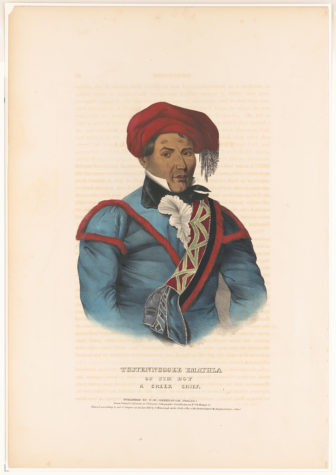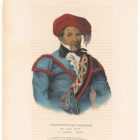Jim Boy or Tustenaggee Emathla: Creek Warrior and Chief
Jim Boy or Tustenaggee Emathla
Creek Warrior and Chief

Jim Boy, or Tustenaggee Emathla, was born about 1790 in the Creek Nation, the birth-place not known. Tustenuggee is the Creek term for “warrior;” Emathla is a war title, corresponding nearly to “disciplinarian.” Nothing is known of Jim Boy’s life prior to the outbreak of the Creek War of 1813, where Pickett calls him High Head Jim. He was chief of the Atossees, and commanded the hostile Creeks at the battle of Burnt Corn, fought March 27, 1813. It is not known in what other battles he was engaged during the war. After its close, he settled near Polecat Spring, and there built a little town called Thlopthlocco. In 1815 he served under General McIntosh against the Seminoles in Florida. During the Creek troubles of 1836, he attached himself to the friendly party. At the close of these troubles he was solicited by General Jessup to raise warriors for service against the Seminoles in Florida. He and Paddy Carr accordingly raised nine hundred and fifty warriors and with them reached the seat of war in September. Here the Creeks were organized into a regiment war in September. Here the Creeks were organized into a regiment and placed under the command of Major David Moniac. Jim Boy was with his regiment in two battles and in a number of skirmishes in the Seminole war. The battles were the second battle of Wahoo Swamp, fought in November 1836, and the battle of Lake Monroe, fought February 8, 1837. The Creeks fought courageously in both these engagements.
On his return from Florida, he found that his family had been removed west in the emigration of the Creeks, and that all his property in the nation had been destroyed. He had joined the army in Florida under a promise of the commending general that his family and property should be cared for, and that he should be remunerated for any loss he might sustain during his absence. This promise was not kept. But all this was a slight trouble compared to the death of four, out of his nine children, who were o£ the two hundred and thirty-six Creeks that were lost in the sinking of the emigration steamboat, Mommouth.
Jim Boy’s home in the Creek Nation west, was near Wetumpka, where he died in 1851. The name of his wife was Nihethoye. Rev. William Jim Boy, a well known Methodist master in the Creek nation, is a grandson.
Jim Boy is described as a remarkably handsome man, full six feet high perfectly formed and with a commanding air. The late Rev John Brown of Daleville, Mississippi, who served in the Seminole War, states that on one occasion, at General Jessup s headquarters, he saw Jim Boy, clad in his full war dress, engaged in conversation with the general; that he was struck with Jim Boy’s appearance, and with the fact that he was by far a finer looking man than General Jessup.
References – McKenney and Hall’s Indian Tribes of North America (1842), vol. iii, 95, 96; Pickett’s History of Alabama (Owen’s Edition, 1900), pp, 521-524; Woodward’s Reminiscences of the Creek or Muscogee Indians, pg. 91, 97, 98; Halbert and Ball’s Creek War, pp. 125-132, 300-301; Drake’s Indians, fifteenth edition, pp. 474, 476, 477, 479.
